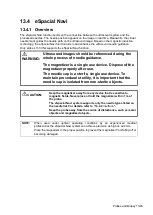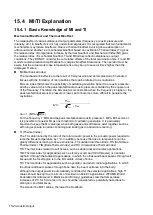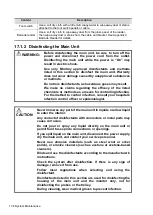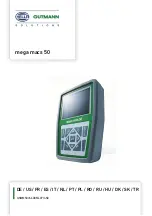
15-4 Acoustic Output
15.6 Acoustic Power Control
A qualified operator may use the system controls to limit the ultrasound output and to adjust the
quality of the images. There are three categories of system controls relating to output. They are:
Controls that have direct effect on the output
Controls that indirectly control the output
Controls that are receiver controls
Direct controls
It is possible to control, if necessary, the acoustic output with the “A. power” item on the
screen. In this case, the maximum value of the acoustic output never exceeds an MI of 1.9
and an I
SPTA.3
of 720 mW/cm
2
in any mode of operation.
Indirect controls
The controls that indirectly affect output are the many imaging parameters. These are
operating modes, frequency, focal point positions, overall depth and PRF.
The operating mode determines whether the ultrasound beam is scanning or non-scanning.
Thermal bioeffect is closely connected to M mode, Doppler and Color mode. Acoustic
attenuation of tissue is directly related to probe frequency. The focal point is related to the
active aperture of the probe and beam width. For higher PRF (pulse repetition frequency),
the more output pulses occur over a period of time.
Receiver controls
The receiver controls (for example, gain, dynamic range and image post-processing, etc.) do
not affect output. These controls should be used, when possible, to improve the image quality
before using controls that directly or indirectly affect output.
15.7 Acoustic Output
15.7.1 Derated Ultrasonic Output Parameters
In order to determine the relevant Ultrasonic Output Parameters, a method is used which allows
for the comparison of ultrasound systems which operate at different frequencies and are focused
at different depths. This approach, called “derating” or “attenuating”, adjusts the acoustic output as
measured in a water tank to account for the effect of ultrasound propagation through tissue. By
convention, a specific average intensity attenuation value is used, which corresponds to a loss of
0.3 dB/cm/MHz. That is, the ultrasound intensity will be reduced by 0.3 dB/MHz for every
centimeter of travel from the probe. This can be expressed by the following equation:
)
10
/
3
.
0
(
10
z
f
water
atten
c
I
I
-
Where I
atten
is the attenuated intensity, I
water
is the intensity measured in a water tank (at distance
z), fc is the center frequency of the ultrasound wave (as measured in water) and z is the distance
from the probe. The equation for attenuating pressure values is similar except that the attenuation
coefficient is 0.15 dB/cm/MHz, or one-half the intensity coefficient. The intensity coefficient is
double the pressure coefficient because intensity is proportional to the square of pressure.
The attenuation coefficient chosen, 0.3 dB/cm/MHz, is significantly lower than any specific solid
tissue in the body. This value was chosen to account for fetal examinations. In early trimester
ultrasound fetal examinations, there may be a significant fluid path between the probe and the
fetus, and the attenuation of fluid is very small. Therefore the attenuation coefficient was lowered
to account for this.
Summary of Contents for TE5
Page 1: ...TE7 TE5 Diagnostic Ultrasound System Operator s Manual Basic Volume ...
Page 2: ......
Page 6: ......
Page 12: ......
Page 24: ......
Page 36: ......
Page 54: ......
Page 110: ......
Page 115: ...Display Cine Review 6 5 6 Tap Return on the screen or tap Freeze to exit image compare ...
Page 120: ......
Page 124: ......
Page 156: ......
Page 174: ......
Page 192: ...12 18 Setup Select Advanced and do as follows Select MAPS and do as follows ...
Page 202: ...13 2 Probes and Biopsy C5 2s L12 4s L7 3s P4 2s L14 6s C11 3s L14 6Ns V11 3Ws P7 3Ts 7LT4s ...
Page 226: ...13 26 Probes and Biopsy NGB 034 NGB 035 ...
Page 250: ......
Page 272: ......
Page 276: ...A 4 Wireless LAN Tap Add Manually create a network profile to set ...
Page 282: ......
Page 318: ......
Page 322: ......
Page 323: ...P N 046 006959 07 1 0 ...
















































